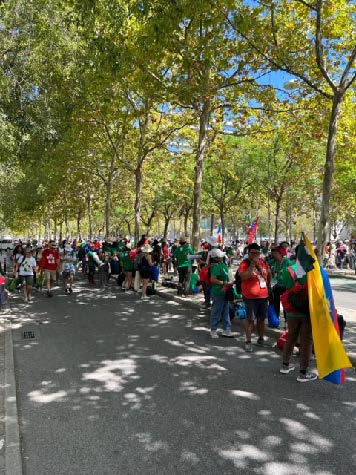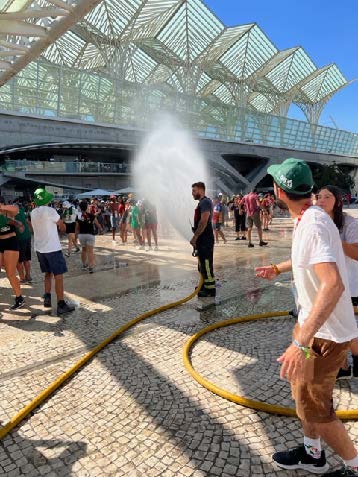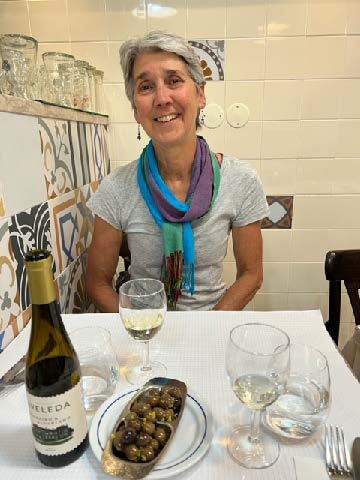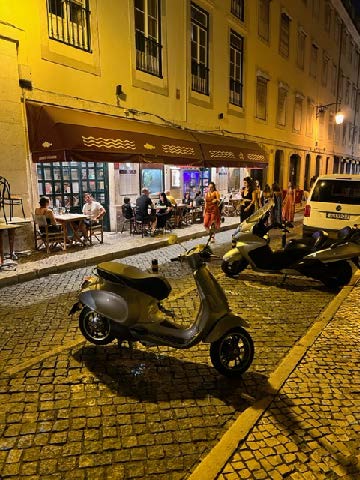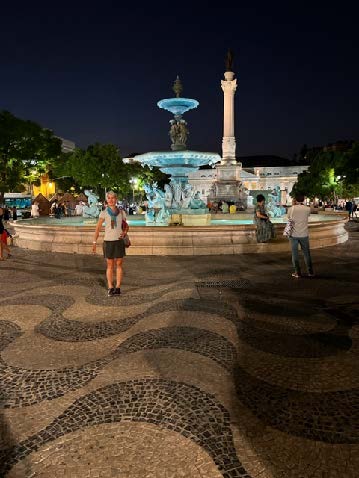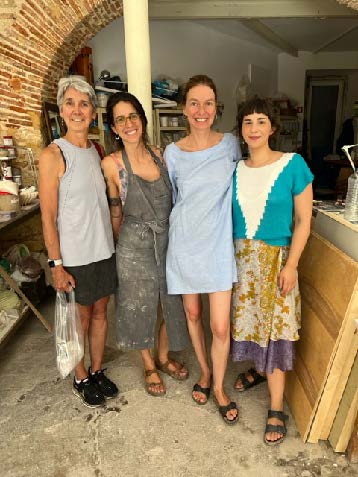We took trains (3) from Madrid to Lisbon. Pretty much an all-day affair. Two of the three trains between Madrid and Lisbon are comfortable, but slow. The middle train is the adventure. Most people would fly between Madrid and Lisbon. Fine, I suppose, but you miss so much. You don’t get to know a country by visiting only its biggest city and passing over the rest at 30,000 ft.
A couple years ago, I biked through Denmark with buddies. We flew into Copenhagen and stayed there a few nights to see the city. After running (not driving) around Copenhagen for a few days, I thought I knew what Denmark and the Danish people were all about. Then, we left the big city and biked through the rural countryside, the smaller towns, the villages. We took ferries across the many islands. After a couple weeks outside Copenhagen, I had a completely different view of what Denmark and the Danish people are. Portugal and Spain are much the same. Take time to get out of the big cities. Trains are not a bad way to do that. Biking is better. Walking is best.
Between and Badajoz, Spain and Abrantes, Portugal it is dry. Arid might be a better word. The train is a single car — a self-powered diesel that struggles to do 30 mph with nothing left over for air conditioning. The terrain alternates between hilly and flat. Most of what grows there is olive trees. As the train rolls west and crosses into Portugal, olive trees give way to cork trees, which I am told is a type of oak. The people who travel these trains are different from the people who fly. The ticket between Badajoz and Abrantes is 16 Euro. The other two tickets between Madrid and Lisbon are similar.
The people who use the train in these parts are locals and college kids on summer backpacking adventures in Europe. So full of wonder and hope. Not yet jaded by the unseen realities around life’s big corners. Not yet knowing how to travel light, they carry packs that are way too big and way too heavy. They sleep where they can. Showers are distant memories. They don’t care because everything they see is new, wondrous, and they are free of parental oversight.
Anyway, we are back in Lisbon. The plan was to be here one night, close to the subway that would take us to the airport the next morning. For that, Leigh Ann chose the 4-star Olispo Orient Hotel, a mere block from the metro station. Very nice, and fine for our purpose.
In a previous post, I described the 5-star hotel Leigh Ann booked for our first pass through Lisbon. So, what is the difference between 4-stars and 5-stars? Honestly, the guest rooms are not much different, nor are the common areas. The 5-star had a gym and pool, which is important to us. The 4-star has neither gym nor pool. Breakfast was, visually, about the same, but the attention to detail was definitely better in the 5-star. The biggest difference we noticed was in the staff. At the 5-star the staff were trained to deliver 5-star service. They smiled, they paid attention to detail, they were proactive in anticipating our wants and needs. They made us feel welcome and we enjoyed interacting with them. At the 4-star, staff were not trained. They were quiet and distant. They did not anticipate. Conversation was limited to “yes” and “no.” If your intent is not to interact, the 4-star is adequate. If you want to learn about the local culture by interacting, the 5-star is a big difference. Subtle differences, perhaps, but noticeable.
Our plan was to be in Lisbon but a single night, and then fly home the next day. The airline had other plans. The morning of our intended departure, I got a text message saying our flight was cancelled for reasons undisclosed. We immediately started damage control. First, talk to the hotel and see if we can stay longer. Answer, yes. Second, go on-line and find a new flight. The first flight home with available seats was three days hence. Booked, and booked. Alert Leigh Ann to the change and get her advice on how to apply for the travel insurance she prompted me to purchase. (By the way, it is now a month since we got home and a month since I filed a claim with the travel insurance company. No response. Grrr. The travel insurance for this trip cost $350. The claim I filed was for about $800. Was it worth it, especially given that the insurance company seems to want to make me fight for reimbursement?) Change a couple meetings back home. We now have three extra days to enjoy Lisbon. Terrific!
What do you do with three extra days in Lisbon. Well, it happened that Sunday was the World Youth Day in the Catholic Church (Jornada Mundial da Juventude in Portuguese) and the Pope was in Lisbon for the event. Lisbon is a city of 1.5 million people. 1.5 million people additional people came to Lisbon for the event. Wow! And, as it happened, the Pope stayed at our hotel. So, there we were, Sunday morning, standing 10 feet from the Pope in front of our hotel. How cool is that?
Mostly, the weather in Lisbon in early August was pleasantly warm. However, on Sunday, after the Pope performed Mass for 1.5 million people, and now all those people were on the move… it was hot. So, Lisbon’s wonderful firefighters took it upon themselves to do what they could. They set up firehoses at the Orient train station and aimed them up in the air. The kids loved it. It was the least we could do to buy cold drinks for the firefighters. Firefighters are a closely connected international family and I am honored to be called “brother” by many I have worked with over the years.
Young people, from all over the world, attending World Youth Day in Lisbon. Many brought their country’s flags to identify themselves
How do you know where to eat dinner in Lisbon. Go out for a walk. Dining is “al fresco” (outside) or inside. Menus are usually posted on the outside wall, or ask to see one.
Dinner in Portugal and Spain begins with wine, olives, bread, and water. Julie prefers agua sin gaz (flat water), and I prefer agua con gaz (sparkling water). If you ask for water from the tap (perfectly fine in Portugal and Spain) in a restaurant, they will likely tell you they do not serve tap water. They make money selling bottled water, and they make nothing giving away tap water.
What to do after dinner? Take a walk down by the water. Lisbon has beautiful sculptures, fountains, and plazas. This photo is one of them down by the harbor after dark.
We have a fun tradition… When we travel, we look for pottery shops. I mean, shops where they actually hand-make the pottery they sell. At these shops we buy one or two cups. No handles. At home, we use them as wine goblets for ourselves and friends. Each cup has a story. Each cup brings back memories. Each cup is a conversation starter. Each cup brings smiles to our faces. So, in Lisbon, we went looking for a pottery shop… and found one on a little back street a few blocks from the busy part of the shopping district. Caulino Handmade Ceramics. The address is: Rua de S. Mamede ao Caldas 28 A e C 1100-535 Lisboa Portugal. The website is: caulinoceramics.com. We bought two little cups and spent nearly half an hour talking. Fun. I’ve included a photo of the shop and Julie posing with the owner and the potters who work with her. The owner is the pretty lady in the light blue dress.
Lisbon is a port city located at the mouth of the Tagus River where it empties into the Atlantic Ocean. The mouth of the Tagus gets very wide and forms the Sea of Straw as it joins the Atlantic. Lisbon, proper, is on the northwest shore of the Sea of Straw. Two bridges cross the Sea of Straw and connect Lisbon to the industrial and residential communities on the other side. Or, you can take a ferry across the Sea of Straw. We took the ferry. It’s only a 20 minute ride and provides a very different view of Portugal only minutes from the big city. On the other side of the Sea of Straw, Portugal feels more like a small town in South America or North Africa.
And then, it was time to fly home. A quick travel tip… Flying out of a foreign country is not like flying into a foreign country, even if it is the same airport. Which terminal to use, where is checkin, where is security, where are the gates, how much time is needed to get through all of that? When possible, we visit the airport a day or two ahead of departure to figure that stuff out, and do it unburdened by luggage. We did that in Lisbon. It cost us 30 minutes and erased all the “where do we go and what do we do” anxiety. Then, when we showed up at the airport the next day to fly home, we knew exactly what to do and where to go.
A word about safety… We were warned before going to Lisbon, Madrid, and Barcelona, and especially doing our travel by train, about pickpockets and other nefarious sorts. We experienced none of that. Nada, zip, zero. The people in all these places were wonderful, welcoming, helpful, and fun. My well-developed “spidy-sense” was never triggered — not even on Lisbon’s crowded Metro (subway). We learned a few words of Portuguese (my Spanish is bad, but workable), and we went out of our way to be kind to people. In turn, they were extraordinarily kind to us. International travel is a wonderful way to spread goodwill.
Would we do this same, identical trip again. Yes, without hesitation. We both loved every minute of it. Leigh Ann can make all the arrangements. Go!

